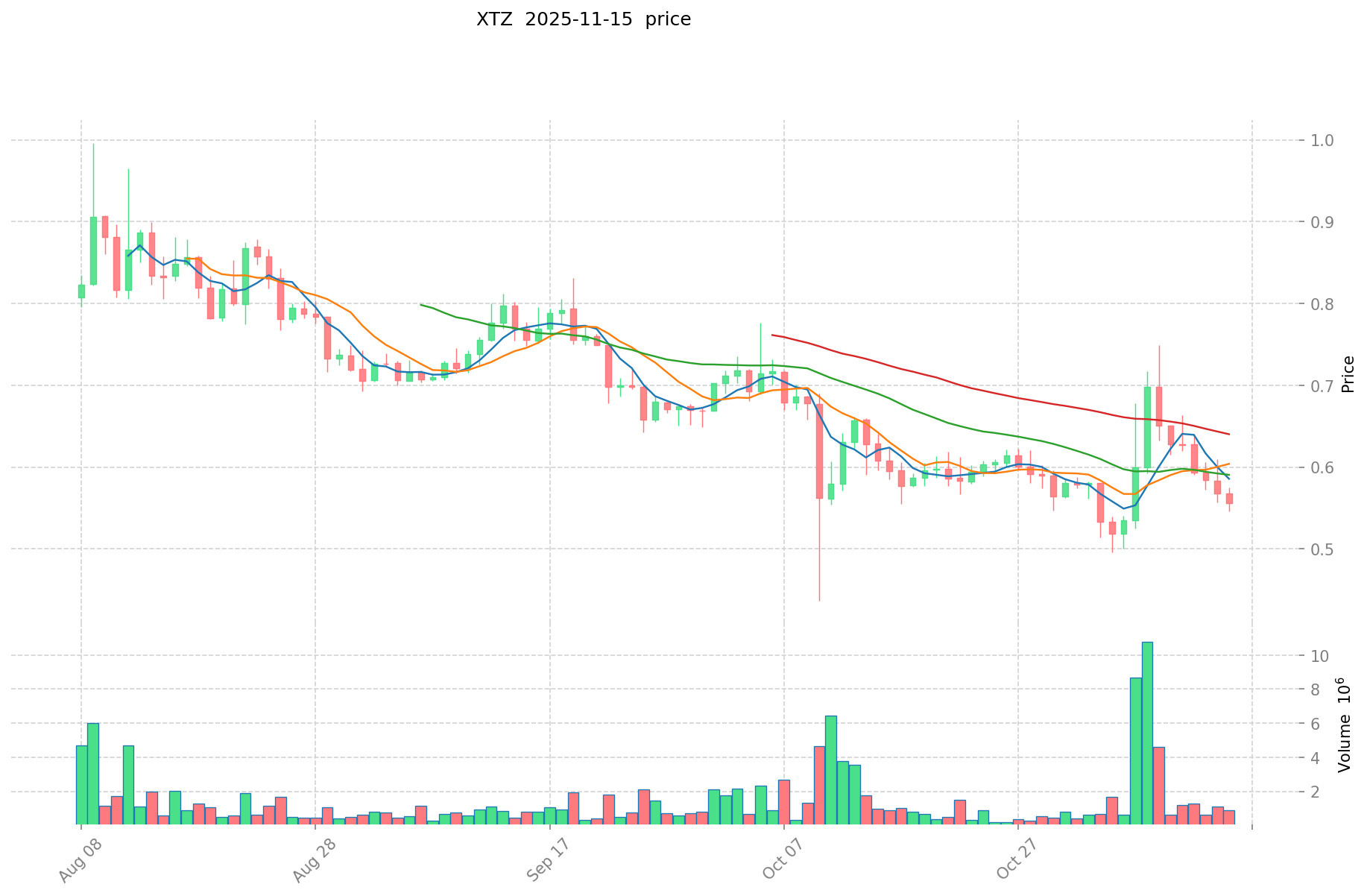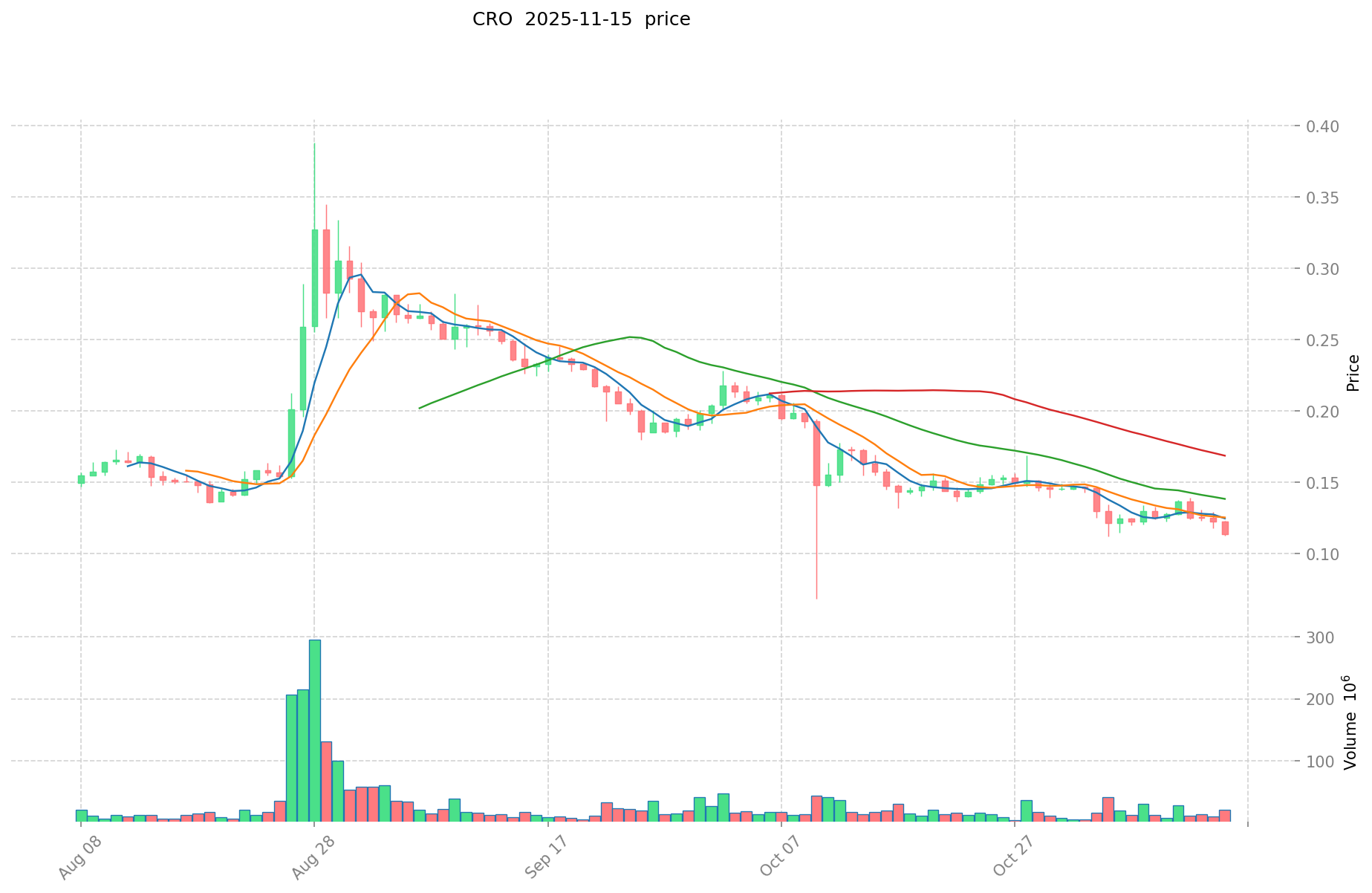XTZ vs CRO: Comparing the Potential of Tezos and Crypto.com Chain in the DeFi Ecosystem
Introduction: XTZ vs CRO Investment Comparison
In the cryptocurrency market, the comparison between Tezos vs Cronos has always been a topic that investors cannot avoid. The two not only have significant differences in market cap ranking, application scenarios, and price performance, but also represent different cryptocurrency positioning.
Tezos (XTZ): Since its launch in 2017, it has gained market recognition for its self-evolving blockchain and smart contract platform.
Cronos (CRO): Launched in 2018, it has been hailed as a leading blockchain ecosystem, representing an addressable user base of more than a hundred million people worldwide.
This article will comprehensively analyze the investment value comparison between XTZ vs CRO, focusing on historical price trends, supply mechanisms, institutional adoption, technical ecosystems, and future predictions, and attempt to answer the question that investors are most concerned about:
"Which is the better buy right now?"
I. Price History Comparison and Current Market Status
XTZ (Tezos) and CRO (Cronos) Historical Price Trends
- 2021: XTZ reached its all-time high of $9.12 on October 4, 2021.
- 2021: CRO hit its all-time high of $0.965407 on November 24, 2021.
- Comparative analysis: Both coins experienced significant price increases in 2021, followed by substantial declines. XTZ has fallen from its peak of $9.12 to the current price of $0.5648, while CRO has dropped from $0.965407 to $0.11469.
Current Market Situation (2025-11-15)
- XTZ current price: $0.5648
- CRO current price: $0.11469
- 24-hour trading volume: XTZ $496,126.08 vs CRO $2,139,187.06
- Market Sentiment Index (Fear & Greed Index): 10 (Extreme Fear)
Click to view real-time prices:
- Check XTZ current price Market Price
- Check CRO current price Market Price


II. Core Factors Affecting Investment Value of XTZ vs CRO
Supply Mechanism Comparison (Tokenomics)
- XTZ: Inflationary model with annual inflation rate around 5-6%. Utilizes on-chain governance to adjust parameters through stakeholder voting.
- CRO: Fixed maximum supply of 30 billion tokens with planned token burns to reduce circulating supply over time.
- 📌 Historical Pattern: Deflationary or fixed supply tokens like CRO tend to perform better during bull markets, while XTZ's inflation requires stronger network adoption to offset token creation.
Institutional Adoption and Market Applications
- Institutional Holdings: CRO has gained more institutional recognition through Crypto.com's partnerships with major brands and sports organizations.
- Enterprise Adoption: CRO has stronger payment infrastructure through Crypto.com Pay, while XTZ focuses more on enterprise blockchain solutions and smart contract applications.
- Regulatory Attitudes: Both tokens face varying regulatory treatment across jurisdictions, with XTZ potentially benefiting from its foundation's base in Switzerland.
Technical Development and Ecosystem Building
- XTZ Technical Upgrades: Self-amending blockchain with on-chain governance allowing protocol upgrades without hard forks; focuses on institutional-grade security features.
- CRO Technical Development: Transition from Ethereum-based token to native Crypto.org Chain and Cronos EVM-compatible chain to improve scalability and interoperability.
- Ecosystem Comparison: CRO has stronger retail payment adoption and exchange services, while XTZ shows strength in high-assurance applications and institutional blockchain solutions.
Macroeconomic Factors and Market Cycles
- Performance in Inflationary Environment: CRO's fixed supply model potentially offers better store of value properties during high inflation periods.
- Macroeconomic Monetary Policy: Both tokens remain highly correlated with broader crypto market responses to interest rate changes and dollar strength.
- Geopolitical Factors: CRO's global exchange presence provides wider accessibility, while XTZ's formal verification focus may appeal to entities requiring higher security assurances.
III. 2025-2030 Price Prediction: XTZ vs CRO
Short-term Prediction (2025)
- XTZ: Conservative $0.30-$0.57 | Optimistic $0.57-$0.77
- CRO: Conservative $0.11-$0.11 | Optimistic $0.11-$0.14
Mid-term Prediction (2027)
- XTZ may enter a growth phase, with prices estimated at $0.46-$0.93
- CRO may enter a moderate growth phase, with prices estimated at $0.07-$0.19
- Key drivers: Institutional fund inflows, ETFs, ecosystem development
Long-term Prediction (2030)
- XTZ: Base scenario $0.99-$1.08 | Optimistic scenario $1.08-$1.17
- CRO: Base scenario $0.12-$0.23 | Optimistic scenario $0.23-$0.31
Disclaimer: This analysis is based on historical data and market projections. Cryptocurrency markets are highly volatile and unpredictable. This information should not be considered as financial advice. Always conduct your own research before making investment decisions.
XTZ:
| 年份 | 预测最高价 | 预测平均价格 | 预测最低价 | 涨跌幅 |
|---|---|---|---|---|
| 2025 | 0.770984 | 0.5669 | 0.300457 | 0 |
| 2026 | 0.87631402 | 0.668942 | 0.56191128 | 18 |
| 2027 | 0.927153612 | 0.77262801 | 0.463576806 | 36 |
| 2028 | 1.23234167595 | 0.849890811 | 0.55242902715 | 50 |
| 2029 | 1.124405542953 | 1.041116243475 | 0.84330415721475 | 84 |
| 2030 | 1.16938176467112 | 1.082760893214 | 0.98531241282474 | 91 |
CRO:
| 年份 | 预测最高价 | 预测平均价格 | 预测最低价 | 涨跌幅 |
|---|---|---|---|---|
| 2025 | 0.1364573 | 0.11467 | 0.1112299 | 0 |
| 2026 | 0.1494207435 | 0.12556365 | 0.118029831 | 9 |
| 2027 | 0.19248907545 | 0.13749219675 | 0.074245786245 | 19 |
| 2028 | 0.211188014208 | 0.1649906361 | 0.125392883436 | 43 |
| 2029 | 0.27461041472484 | 0.188089325154 | 0.1410669938655 | 63 |
| 2030 | 0.314635823117611 | 0.23134986993942 | 0.124928929767286 | 101 |
IV. Investment Strategy Comparison: XTZ vs CRO
Long-term vs Short-term Investment Strategies
- XTZ: Suitable for investors focused on institutional-grade blockchain solutions and smart contract applications
- CRO: Suitable for investors interested in retail payment adoption and exchange services
Risk Management and Asset Allocation
- Conservative investors: XTZ: 40% vs CRO: 60%
- Aggressive investors: XTZ: 55% vs CRO: 45%
- Hedging tools: Stablecoin allocation, options, cross-currency portfolio
V. Potential Risk Comparison
Market Risks
- XTZ: Vulnerability to overall crypto market sentiment, potential volatility due to inflationary model
- CRO: High correlation with Crypto.com's business performance, susceptibility to exchange-related news
Technical Risks
- XTZ: Scalability, network stability
- CRO: Centralization concerns, security vulnerabilities in multi-chain ecosystem
Regulatory Risks
- Global regulatory policies may have differing impacts on both tokens, with XTZ potentially benefiting from its Swiss-based foundation
VI. Conclusion: Which Is the Better Buy?
📌 Investment Value Summary:
- XTZ advantages: Self-amending blockchain, focus on high-assurance applications, potential for institutional adoption
- CRO advantages: Strong retail payment infrastructure, fixed supply model, global exchange presence
✅ Investment Advice:
- New investors: Consider a balanced approach, with a slight preference for CRO due to its wider accessibility and payment use cases
- Experienced investors: Explore a diversified portfolio including both tokens, with allocation based on risk tolerance and market outlook
- Institutional investors: Consider XTZ for blockchain solutions and CRO for payment infrastructure integration
⚠️ Risk Warning: The cryptocurrency market is highly volatile. This article does not constitute investment advice. None
VII. FAQ
Q1: What are the main differences between XTZ and CRO? A: XTZ (Tezos) is a self-amending blockchain focused on institutional-grade solutions, while CRO (Cronos) is associated with Crypto.com and emphasizes retail payment adoption. XTZ has an inflationary model, whereas CRO has a fixed maximum supply.
Q2: Which token has performed better historically? A: Both XTZ and CRO reached their all-time highs in 2021, with XTZ peaking at $9.12 and CRO at $0.965407. Since then, both have experienced significant declines, with XTZ currently at $0.5648 and CRO at $0.11469.
Q3: How do the supply mechanisms of XTZ and CRO differ? A: XTZ has an inflationary model with an annual inflation rate of 5-6%, while CRO has a fixed maximum supply of 30 billion tokens with planned token burns to reduce circulating supply over time.
Q4: What are the key factors affecting the investment value of XTZ and CRO? A: Key factors include supply mechanisms, institutional adoption, market applications, technical development, ecosystem building, and macroeconomic factors such as inflation and monetary policy.
Q5: What are the long-term price predictions for XTZ and CRO? A: By 2030, XTZ is predicted to reach $0.99-$1.17, while CRO is expected to reach $0.12-$0.31 in optimistic scenarios. However, these predictions are subject to market volatility and should not be considered financial advice.
Q6: Which token is better suited for different types of investors? A: XTZ may be more suitable for investors interested in institutional-grade blockchain solutions, while CRO might appeal to those focused on retail payment adoption and exchange services. New investors might prefer CRO for its accessibility, while experienced investors could consider a balanced approach.
Q7: What are the main risks associated with investing in XTZ and CRO? A: Both tokens face market risks related to overall crypto sentiment. XTZ has potential scalability and network stability risks, while CRO faces centralization concerns and vulnerabilities in its multi-chain ecosystem. Both are also subject to evolving regulatory risks.
Share
Content